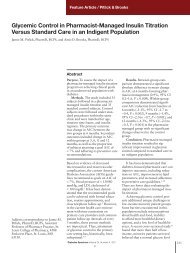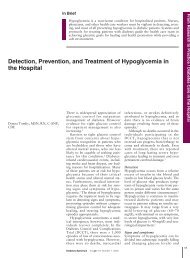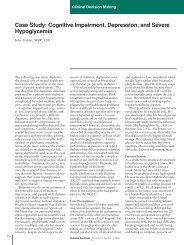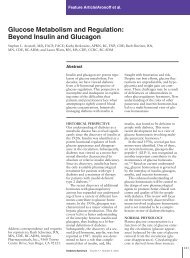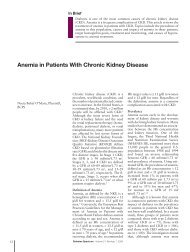Point-of-Care Testing in Diabetes Management: What Role Does It ...
Point-of-Care Testing in Diabetes Management: What Role Does It ...
Point-of-Care Testing in Diabetes Management: What Role Does It ...
Create successful ePaper yourself
Turn your PDF publications into a flip-book with our unique Google optimized e-Paper software.
<strong>of</strong> POCT. As one participant summed<br />
it up, “Who’s go<strong>in</strong>g to cover the cost<br />
<strong>of</strong> this? . . . <strong>It</strong>’s not so much the equipment<br />
<strong>in</strong> the first place, but to keep the<br />
sticks on hand to be used on patients<br />
can be costly, and if that’s not covered,<br />
then why would a physician do<br />
it this way? Why wouldn’t they send<br />
the work out to a lab?”<br />
If these f<strong>in</strong>ancial issues could be<br />
resolved, participants believed that<br />
POCT would promote an efficient use<br />
<strong>of</strong> time and would therefore be cost<br />
sav<strong>in</strong>g. For example, some physicians<br />
justified the expenditure <strong>of</strong> <strong>in</strong>creased<br />
time by themselves and their staff at<br />
the outset as potentially sav<strong>in</strong>g time <strong>in</strong><br />
the future. “<strong>It</strong> would <strong>in</strong>crease the<br />
length <strong>of</strong> a patient visit, but it would<br />
decrease the phone calls and staff time<br />
later on.” Many participants justified<br />
the extra time required as possibly<br />
time sav<strong>in</strong>g. “If you compare it to<br />
hav<strong>in</strong>g to follow-up a week, two<br />
weeks, a month later with results, I<br />
th<strong>in</strong>k ultimately it would save you<br />
time.” Patients also perceived a costsav<strong>in</strong>g<br />
potential. “If this could be<br />
done <strong>in</strong> the doctor’s <strong>of</strong>fice, the<br />
amount <strong>of</strong> money it would save <strong>in</strong> the<br />
health care system is phenomenal.”<br />
DISCUSSION<br />
This study provides unique <strong>in</strong>sights<br />
<strong>in</strong>to how POCT may change and<br />
enhance the cl<strong>in</strong>ical encounter and<br />
thus improve patient management.<br />
Furthermore, the study f<strong>in</strong>d<strong>in</strong>gs identify<br />
barriers to implementation, <strong>in</strong><br />
particular the cost <strong>of</strong> POCT.<br />
Immediacy and convenience were<br />
viewed as important benefits <strong>of</strong><br />
POCT. Be<strong>in</strong>g able to provide and discuss<br />
the results face-to-face rather<br />
than over the telephone was felt to<br />
have more <strong>of</strong> an impact on patients. <strong>It</strong><br />
also allowed HPCs to recommend<br />
changes <strong>in</strong> management at that visit.<br />
Furthermore, the opportunity to provide<br />
test results immediately, <strong>in</strong> a faceto-face<br />
encounter, was perceived by<br />
participants as promot<strong>in</strong>g shared decision<br />
mak<strong>in</strong>g.<br />
More than a decade ago, Kaplan et<br />
al. 14 produced compell<strong>in</strong>g evidence<br />
about the impact <strong>of</strong> <strong>in</strong>formation shar<strong>in</strong>g<br />
and active patient participation<br />
dur<strong>in</strong>g patient-doctor <strong>in</strong>teractions on<br />
patient health outcomes. A more<br />
recent study by Little et al. 15 found<br />
that patients expect communication<br />
with their physician to <strong>in</strong>clude <strong>in</strong>for-<br />
Feature Article/Brown et al.<br />
mation shar<strong>in</strong>g and expect to be<br />
engaged as a partner <strong>in</strong> their care.<br />
Our f<strong>in</strong>d<strong>in</strong>gs reflect<strong>in</strong>g the views <strong>of</strong><br />
multiple HCPs and patients endorse<br />
this prior research.<br />
Perhaps most importantly, our participants<br />
viewed POCT as an opportunity<br />
to capitalize on patient education.<br />
As Price 16 stated, POCT “will be beneficial<br />
only if appropriate action is<br />
taken on the result.” Therefore, it<br />
may not be sufficient to simply report<br />
results to the patient; that must be<br />
accompanied by comprehensive diabetes<br />
management that motivates<br />
patients to assume a greater level <strong>of</strong><br />
self-care.<br />
Participants’ expectations that<br />
POCT would positively impact patient<br />
outcomes, such as adherence and<br />
immediate adjustments to hyperglycemia<br />
management, have been<br />
found <strong>in</strong> prior research. 8–10 Participants<br />
generally viewed POCT as a potential<br />
time saver (i.e., fewer telephone contacts<br />
and return visits), although this<br />
has not been found <strong>in</strong> prior research. 9<br />
Although our participants strongly<br />
endorsed the value and advantages <strong>of</strong><br />
POCT, logistical factors could still<br />
prevent the implementation <strong>of</strong> this<br />
technology. Our f<strong>in</strong>d<strong>in</strong>gs revealed<br />
concerns about accuracy as be<strong>in</strong>g<br />
foundational to any discussion <strong>of</strong><br />
us<strong>in</strong>g POCT. F<strong>in</strong>ancial issues were the<br />
other pr<strong>in</strong>cipal concern <strong>of</strong> the participants<br />
and dom<strong>in</strong>ated the discussion.<br />
Costs associated with POCT have<br />
been noted previously. 16,17 Participants’<br />
concerns reiterated observations made<br />
by Delaney et al., 18 who observed that<br />
without evidence to support the cost<br />
effectiveness <strong>of</strong> POCT, the implementation<br />
<strong>of</strong> this technology <strong>in</strong> primary<br />
health care sett<strong>in</strong>gs would be low. A<br />
review by Baer 19 <strong>of</strong> the cost <strong>of</strong> POCT<br />
versus perform<strong>in</strong>g the same tests <strong>in</strong> laboratories<br />
found that approximately<br />
half <strong>of</strong> the studies reported POCT as<br />
be<strong>in</strong>g less expensive. Even when consider<strong>in</strong>g<br />
the cost <strong>of</strong> POCT <strong>in</strong> the hospital<br />
sett<strong>in</strong>g, there is contradictory evidence.<br />
17,20 Dolega 21 has called for outcome<br />
studies to balance the cost <strong>of</strong><br />
POCT with medical need, doctor and<br />
patient preference, and the effect on<br />
total health care costs.<br />
Hence, cost may be the driv<strong>in</strong>g force<br />
beh<strong>in</strong>d the implementation <strong>of</strong> POCT.<br />
Rapid advancements <strong>in</strong> POCT technology<br />
may elim<strong>in</strong>ate many <strong>of</strong> the logistical<br />
concerns, such as space require-<br />
<strong>Diabetes</strong> Spectrum Volume 17, Number 4, 2004<br />
ments and accuracy. But until issues <strong>of</strong><br />
remuneration are addressed, specifically<br />
for community-based practitioners,<br />
the cost will rema<strong>in</strong> a concern, and<br />
implementation will be stalled.<br />
CONCLUSIONS<br />
Hav<strong>in</strong>g access to immediate results<br />
can help improve HCPs’ communication<br />
and collaboration <strong>in</strong> the management<br />
<strong>of</strong> their patients with diabetes.<br />
This <strong>in</strong>formation promotes face-t<strong>of</strong>ace<br />
communication not only between<br />
patients and providers but also among<br />
HPCs. Furthermore, patient education<br />
efforts can be coord<strong>in</strong>ated and re<strong>in</strong>forced<br />
by all HCPs work<strong>in</strong>g with a<br />
given patient.<br />
Participants viewed the ability to<br />
accelerate the cl<strong>in</strong>ical decision-mak<strong>in</strong>g<br />
process, specifically at the time <strong>of</strong> the<br />
patient visit, as an important aspect <strong>of</strong><br />
POCT <strong>in</strong> diabetes management, and<br />
this is supported by prior research. 22<br />
This also re<strong>in</strong>forces patient-centered<br />
practice, which encourages management<br />
decisions to be specific to patient<br />
needs, promote partnerships between<br />
both patients and HPCs, allow opportunities<br />
for prevention and health promotion,<br />
and enhance patient-HPC<br />
<strong>in</strong>teractions through improved communication<br />
and f<strong>in</strong>d<strong>in</strong>g common<br />
ground regard<strong>in</strong>g management. 23,24<br />
Patient education will then transpire<br />
with<strong>in</strong> an <strong>in</strong>teraction between patients<br />
and HPCs that promotes self-care<br />
behavior.<br />
Acknowledgment<br />
Bayer Corp. provided funds to support<br />
this research through an unrestricted<br />
research grant.<br />
References<br />
1 U.K. Prospective <strong>Diabetes</strong> Study Group:<br />
Intensive blood-glucose control with sulphonylureas<br />
or <strong>in</strong>sul<strong>in</strong> compared with conventional<br />
treatment and risk <strong>of</strong> complications <strong>in</strong> patients<br />
with type 2 diabetes (UKPDS 33). Lancet<br />
352:837–853, 1998<br />
2 U.K. Prospective <strong>Diabetes</strong> Study Group:<br />
Efficacy <strong>of</strong> atenolol and captopril <strong>in</strong> reduc<strong>in</strong>g<br />
risk <strong>of</strong> macrovascular and microvascular complications<br />
<strong>in</strong> type 2 diabetes (UKPDS 39). BMJ<br />
317:713–720, 1998<br />
3 U.K. Prospective <strong>Diabetes</strong> Study Group: Tight<br />
blood pressure control and risk <strong>of</strong> macrovascular<br />
and microvascular complications <strong>in</strong> type 2 diabetes<br />
(UKPDS 38). BMJ 317:703–713, 1998<br />
4 Slocum W, Ziemer DC, Culler SD, Cook CB,<br />
Ferguson SY: Poor appo<strong>in</strong>tment keep<strong>in</strong>g behav-<br />
247



